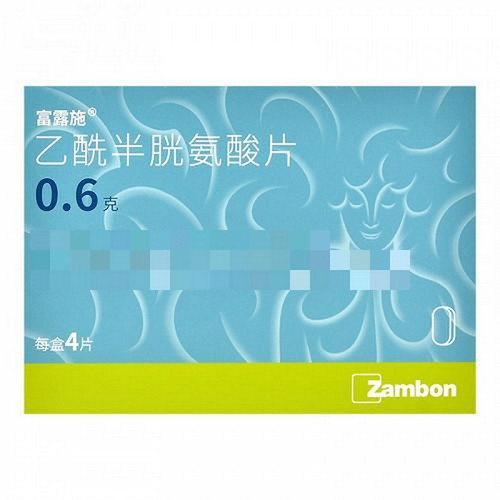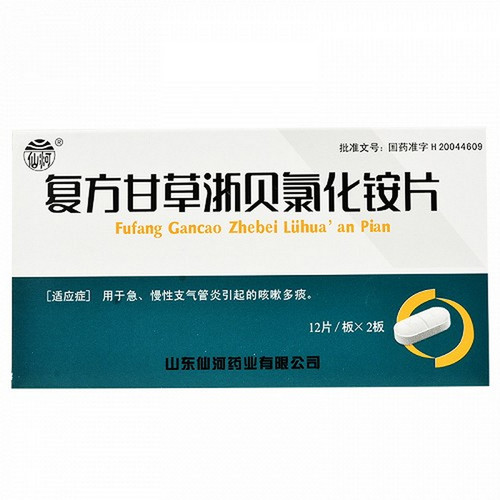Product Overview
[Drug Name]
Generic Name: Acetylcysteine Effervescent Tablets
Trade Name: Jinkang Suli
English Name: Acetylcysteine Effervescent Tablets
Chinese Pinyin: Yi Xian Ban Guang An Suan Paoteng Pian
[Ingredients]
Main ingredient: Acetylcysteine.
[Appearance]
White, round effervescent tablets with a lemony and slightly sulfurous odor.
[Indications]
For the treatment of chronic respiratory infections such as chronic obstructive pulmonary disease (COPD), chronic bronchitis (CB), and emphysema (PE) with excessive, thick sputum secretion.
[Dosage]
Adults: 600 mg (one tablet) once or twice daily. Dissolve the tablet in half a cup of warm water (≤40°C), stirring with a spoon if necessary. It is best to take the tablet at night.
[Adverse Reactions]
Oral administration of this product may occasionally cause allergic reactions, such as urticaria and, rarely, bronchospasm. Gastrointestinal irritation, such as nausea and vomiting, may occur during oral administration.
[Contraindications]
This product is contraindicated in patients allergic to acetylcysteine. This product contains aspartame and is contraindicated in patients with phenylketonuria.
[Precautions]
Patients with bronchial asthma should be closely monitored during treatment. If bronchospasm occurs, treatment should be discontinued immediately. The product may have a sulfurous odor, which is not due to product deterioration but is a characteristic of the active ingredient in this formulation. This product should not be swallowed directly. Dissolved crystals should not be mixed with other medications. This product should be stored out of reach of children and used within the expiration date.
[Use in Special Populations]
Precautions for Pediatric Patients: This product is for adults only.
Precautions for Pregnancy and Lactation: Animal studies have shown that this product is not teratogenic. Data on its use in pregnant and lactating women are lacking. Therefore, use is not recommended for pregnant women, and breastfeeding is not recommended during treatment.
Precautions for Elderly Patients: The pharmacokinetic profile of this product does not change significantly in elderly patients, and dosing generally does not require adjustment.
[Drug Interactions]
This product can be used in combination with medications such as bronchodilators and vasoconstrictors.
[Pharmacological Actions]
The active ingredient in this product is N-acetyl-L-cysteine (NAC), which exerts a strong mucolytic effect by breaking down mucin complexes and nucleic acids, reducing the purulent components of sputum and other mucus and mucous secretions from viscous to thinner. Furthermore, this product exerts a direct antioxidant effect through a free sulfhydryl group (nucleophilic -SH) that directly interacts with electrophilic oxidizing groups. This product protects alpha-1 antitrypsin (an inhibitor of elastase) from inactivation by hypochlorous acid (HOCl), a strong oxidant produced by activated myeloperoxidase in phagocytes. These properties make this product particularly suitable for the treatment of acute and chronic respiratory infections characterized by thick mucus and mucous secretions. Furthermore, this product's molecular structure allows it to easily penetrate cell membranes. Within cells, this product deacetylates to form L-cysteine, an essential amino acid for the synthesis of glutathione (GSH). GSH is a highly active tripeptide found in a wide variety of animal tissues. Glutathione is the most important protective agent within cells, essential for maintaining the integrity of cell function and morphology. It protects cells from damage by naturally occurring oxygen free radicals and various cytotoxic substances. This product plays a crucial role in maintaining appropriate GSH levels, thereby helping to protect cells from cytotoxic damage caused by low GSH levels, such as in acetaminophen poisoning. Due to this mechanism of action, this product can also serve as a specific antidote in acetaminophen poisoning, during cyclophosphamide therapy, and in hemorrhagic cystitis. (In the latter case, this product provides the sulfhydryl group necessary to inactivate acrolein, a toxic metabolite that affects the urinary tract mucosa, without interfering with chemotherapy.) Acute Toxicity: NAC has low acute toxicity when administered orally, intraperitoneally, orally, or intravenously. The LD50 values for a single oral dose in normally fed rats and mice were 10 kg and 8 g/kg, respectively. Intravenous administration was 2.8 g/kg in rats and 4.6 g in mice. Long-Term Toxicity: In repeated-dose studies, rats tolerated oral administration of 1 g/kg/day for 12 weeks and 6 months well. Dogs received oral administration of 300 mg/kg/day for 1 year without any toxic effects. Reproductive Toxicity Studies: High-dose acetylcysteine administration during pregnancy in rats and rabbits did not result in teratogenic effects on the offspring during uterine development. Mutagenicity Studies: Acetylcysteine is not mutagenic (Ames test). Carcinogenicity
[Studies]
Toxicity studies in animals and humans have shown no mutagenicity; therefore, no carcinogenicity testing has been conducted.
[Storage]
Store tightly sealed at room temperature.
[Strength]
0.6g
[Packaging]
600mg x 6 tablets/box
[Expiration Period]
24 months
[Approval Number]
National Medical Products Administration H20057334
[Manufacturer]
Zhejiang Jinhua Kangenbei Biopharmaceutical Co., Ltd.






